| Look up complementarity or complementary in Wiktionary, the free dictionary. |
Complementarity may refer to:
| Look up complementarity or complementary in Wiktionary, the free dictionary. |
Complementarity may refer to:
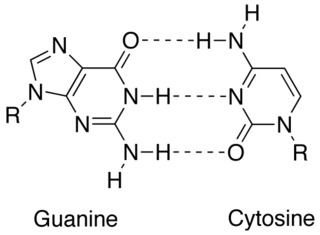
In molecular biology, complementarity describes a relationship between two structures each following the lock-and-key principle. In nature complementarity is the base principle of DNA replication and transcription as it is a property shared between two DNA or RNA sequences, such that when they are aligned antiparallel to each other, the nucleotide bases at each position in the sequences will be complementary, much like looking in the mirror and seeing the reverse of things. This complementary base pairing allows cells to copy information from one generation to another and even find and repair damage to the information stored in the sequences.
In physics, complementarity is both a theoretical and an experimental result of quantum mechanics, also referred to as principle of complementarity. Formulated by Niels Bohr, a leading founder of quantum mechanics, the complementarity principle holds that objects have certain pairs of complementary properties which cannot all be observed or measured simultaneously.
A complementarity problem is a type of mathematical optimization problem. It is the problem of optimizing a function of two vector variables subject to certain requirements (constraints) which include: that the inner product of the two vectors must equal zero, i.e. they are orthogonal. In particular for finite-dimensional real vector spaces this means that, if one has vectors X and Y with all nonnegative components, then for each pair of components xi and yi one of the pair must be zero, hence the name complementarity. e.g. X = (1, 0) and Y = (0, 2) are complementary, but X = (1, 1) and Y = (2, 0) are not. A complementarity problem is a special case of a variational inequality.
Complementarianism is a theological view in Christianity, Judaism, and Islam, that men and women have different but complementary roles and responsibilities in marriage, family life, religious leadership, and elsewhere. The word "complementary" and its cognates are currently used to denote this view. For Christians whose complementarian view is biblically-prescribed, these separate roles preclude women from specific functions of ministry within the community. Though women may be precluded from certain roles and ministries they are held to be equal in moral value and of equal status. The phrase used to describe this is 'Ontologically equal, Functionally different'.

In economics, a complementary good or complement is a good with a negative cross elasticity of demand, in contrast to a substitute good. This means a good's demand is increased when the price of another good is decreased. Conversely, the demand for a good is decreased when the price of another good is increased. If goods A and B are complements, an increase in the price of A will result in a leftward movement along the demand curve of A and cause the demand curve for B to shift in; less of each good will be demanded. A decrease in the price of A will result in a rightward movement along the demand curve of A and cause the demand curve B to shift outward; more of each good will be demanded. Basically this means that since the demand of one good is linked to the demand for another good, if a higher quantity is demanded of one good, a higher quantity will also be demanded of the other, and if a lower quantity is demanded of one good, a lower quantity will be demanded of the other.

Complementarity-determining regions (CDRs) are part of the variable chains in immunoglobulins (antibodies) and T cell receptors, generated by B-cells and T-cells respectively, where these molecules bind to their specific antigen. A set of CDRs constitutes a paratope. As the most variable parts of the molecules, CDRs are crucial to the diversity of antigen specificities generated by lymphocytes.
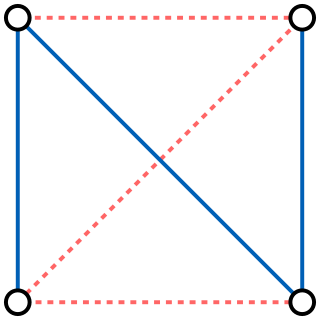
A self-complementary graph is a graph which is isomorphic to its complement. The simplest non-trivial self-complementary graphs are the 4-vertex path graph and the 5-vertex cycle graph.
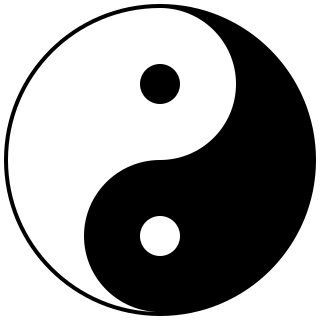
In Chinese philosophy, yin and yang is a concept of dualism in ancient Chinese philosophy, describing how seemingly opposite or contrary forces may actually be complementary, interconnected, and interdependent in the natural world, and how they may give rise to each other as they interrelate to one another. In Chinese cosmology, the universe creates itself out of a primary chaos of material energy, organized into the cycles of Yin and Yang and formed into objects and lives. Yin is the receptive and Yang the active principle, seen in all forms of change and difference such as the annual cycle, the landscape, sexual coupling, the formation of both men and women as characters, and sociopolitical history.
| This disambiguation page lists articles associated with the title Complementarity. If an internal link led you here, you may wish to change the link to point directly to the intended article. |
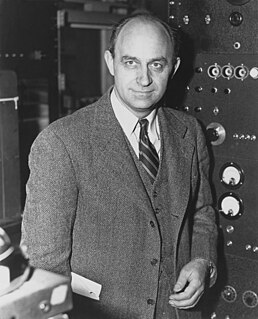
In particle physics, a fermion is a particle that follows Fermi–Dirac statistics. These particles obey the Pauli exclusion principle. Fermions include all quarks and leptons, as well as all composite particles made of an odd number of these, such as all baryons and many atoms and nuclei. Fermions differ from bosons, which obey Bose–Einstein statistics.

A quark is a type of elementary particle and a fundamental constituent of matter. Quarks combine to form composite particles called hadrons, the most stable of which are protons and neutrons, the components of atomic nuclei. Due to a phenomenon known as color confinement, quarks are never directly observed or found in isolation; they can be found only within hadrons, which include baryons and mesons. For this reason, much of what is known about quarks has been drawn from observations of hadrons.

In particle physics, a pion is any of three subatomic particles:
π0
,
π+
, and
π−
. Each pion consists of a quark and an antiquark and is therefore a meson. Pions are the lightest mesons and, more generally, the lightest hadrons. They are unstable, with the charged pions
π+
and
π−
decaying with a mean lifetime of 26.033 nanoseconds, and the neutral pion
π0
decaying with a much shorter lifetime of 8.4×10−17 seconds. Charged pions most often decay into muons and muon neutrinos, while neutral pions generally decay into gamma rays.

In the physical sciences, subatomic particles are particles much smaller than atoms. The two types of subatomic particles are: elementary particles, which according to current theories are not made of other particles; and composite particles. Particle physics and nuclear physics study these particles and how they interact. The idea of a particle underwent serious rethinking when experiments showed that light could behave like a stream of particles as well as exhibiting wave-like properties. This led to the new concept of wave–particle duality to reflect that quantum-scale "particles" behave like both particles and waves. Another new concept, the uncertainty principle, states that some of their properties taken together, such as their simultaneous position and momentum, cannot be measured exactly. In more recent times, wave–particle duality has been shown to apply not only to photons but to increasingly massive particles as well.
Meta-systems have several definitions. In general, they link the concepts "system" and "meta-". A "meta-system" is about other systems, such as describing, generalizing, modelling, or analyzing the other system(s).
In particle physics, the baryon number is a strictly conserved additive quantum number of a system. It is defined as
In physics, an infrared fixed point is a set of coupling constants, or other parameters that evolve from initial values at very high energies, to fixed stable values, usually predictable, at low energies. This usually involves the use of the renormalization group, which specifically details the way parameters in a physical system depend on the energy scale being probed.
In particle physics, preons are point particles, conceived of as subcomponents of quarks and leptons. The word was coined by Jogesh Pati and Abdus Salam in 1974. Interest in preon models peaked in the 1980s but has slowed as the Standard Model of particle physics continues to describe the physics mostly successfully, and no direct experimental evidence for lepton and quark compositeness has been found.
In particle physics, flavour or flavor refers to the species of an elementary particle. The Standard Model counts six flavours of quarks and six flavours of leptons. They are conventionally parameterized with flavour quantum numbers that are assigned to all subatomic particles. They can also be described by some of the family symmetries proposed for the quark-lepton generations.
Leptoquarks are hypothetical particles that carry information between quarks and leptons of a given generation that allow quarks and leptons to interact. They are color-triplet bosons that carry both lepton and baryon numbers. They are encountered in various extensions of the Standard Model, such as technicolor theories or GUTs based on Pati–Salam model, SU(5) or E6, etc. Their quantum numbers like spin, (fractional) electric charge and weak isospin vary among theories.
The Koide formula is an unexplained empirical equation discovered by Yoshio Koide in 1981. In its original form, it relates the masses of the three charged leptons; later authors have extended the relation to neutrinos, quarks, and other families of particles.
The quark–lepton complementarity (QLC) is a possible fundamental symmetry between quarks and leptons. First proposed in 1990 by Foot and Lew, it assumes that leptons as well as quarks come in three "colors". Such theory may reproduce the Standard Model at low energies, and hence quark–lepton symmetry may be realized in nature.
In particle physics, the X and Y bosons are hypothetical elementary particles analogous to the W and Z bosons, but corresponding to a new type of force predicted by the Georgi–Glashow model, a grand unified theory.
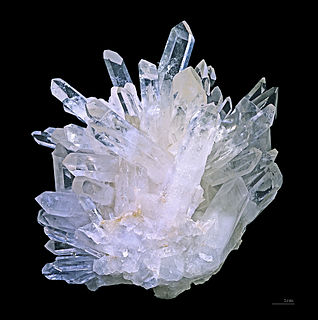
In classical physics and general chemistry, matter is any substance that has mass and takes up space by having volume. All everyday objects that can be touched are ultimately composed of atoms, which are made up of interacting subatomic particles, and in everyday as well as scientific usage, "matter" generally includes atoms and anything made up of them, and any particles that act as if they have both rest mass and volume. However it does not include massless particles such as photons, or other energy phenomena or waves such as light or sound. Matter exists in various states. These include classical everyday phases such as solid, liquid, and gas – for example water exists as ice, liquid water, and gaseous steam – but other states are possible, including plasma, Bose–Einstein condensates, fermionic condensates, and quark–gluon plasma.
The index of physics articles is split into multiple pages due to its size.
QLC or qlc may refer to: